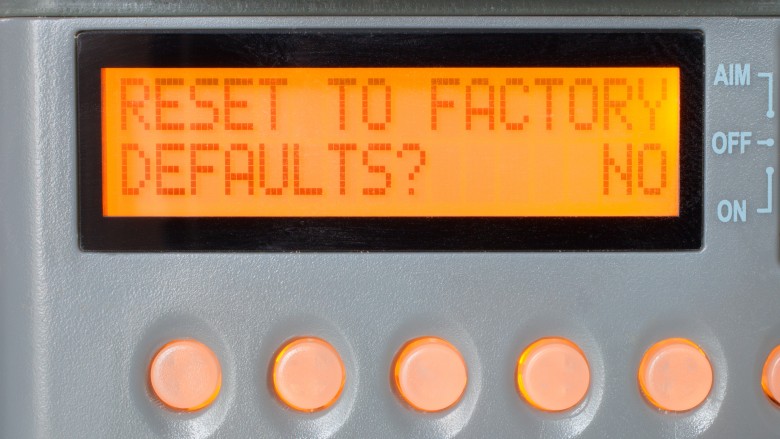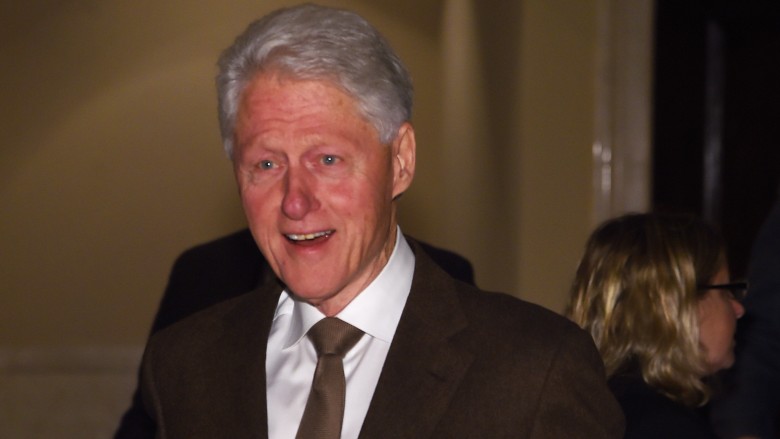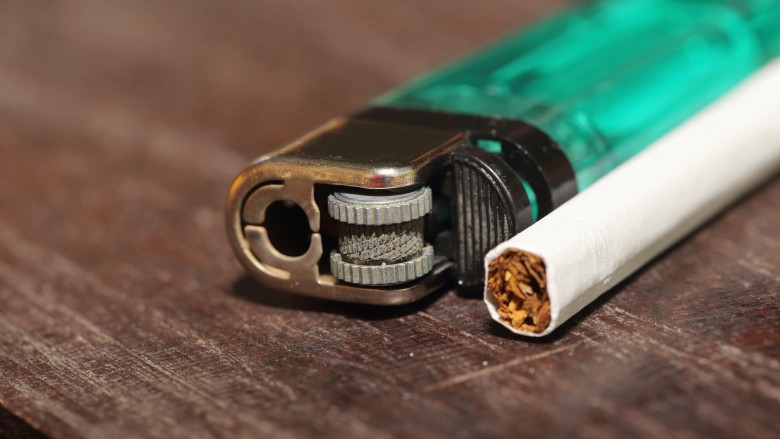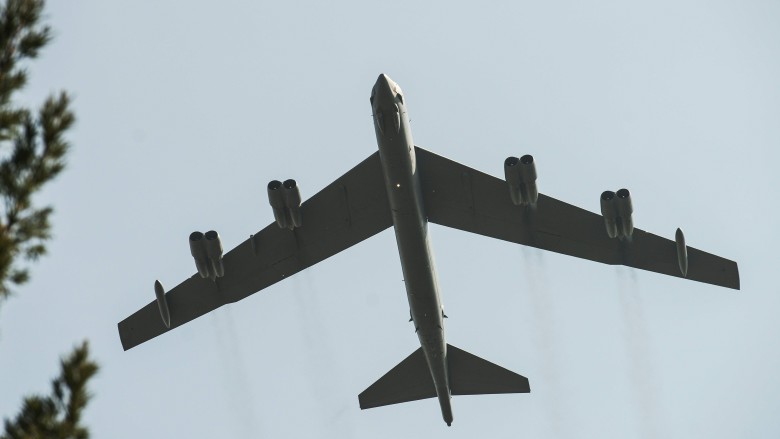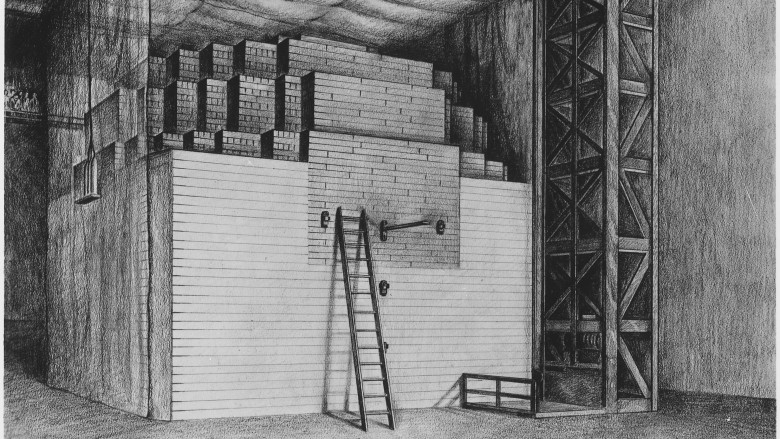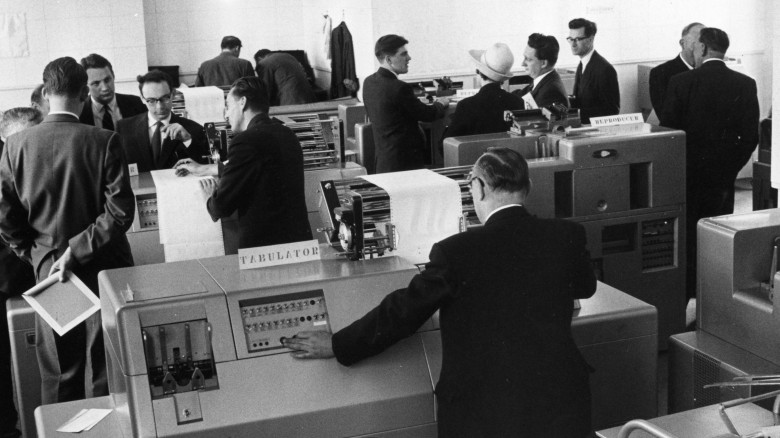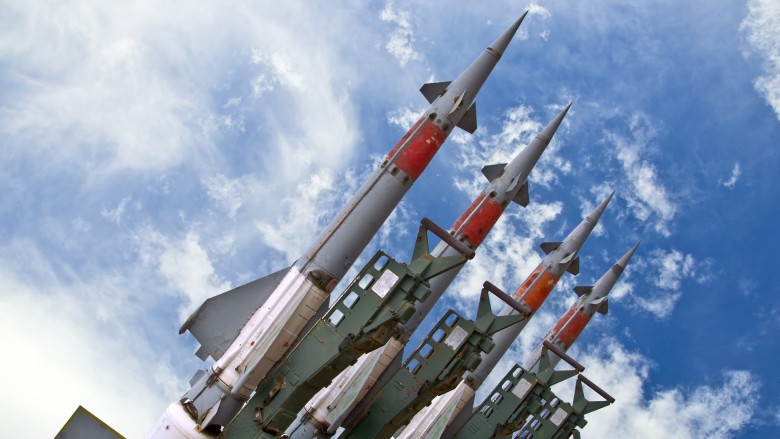Hilarious Things That Really Happened With Nuclear Weapons
Nuclear weapons are literally the most metal thing ever made. All the grammar Nazis in the crowd can settle down because nuclear weapons are constructed using actual heavy metals. Check out the periodic table if you don't believe us. Anyway, nukes can destroy the world, and because of that, they're treated with the utmost respect. Unfortunately, nukes are also handled by human beings, and human beings have an uncanny knack for being able to do some impressively stupid things when they think nobody's watching.
America's nuclear launch code was set to default
There's a very complicated process for using nuclear weapons, for a very good reason. Theoretically, the military would choose a target, make their case to the president, who would then authorize the use of nuclear weapons by typing a unique launch code unique into a briefcase-size device referred to as the "nuclear football." At that point, over the course of a few minutes, the nukes would be armed, sent toward their target, and we all start cosplaying as Fallout characters full time.
The entire process for ending the world hinges on the president's authorization, so it was a little frightening that the president's launch code for American-based nuclear weapons was set to 00000000 for twenty years or so. The military claimed that they needed a simple and streamlined system in place because in the event of a nuclear attack, a response would have to be made almost instantly. Typing in a super complicated code would add dozens of seconds to the time it would take to destroy half the world, and that was something the military could not live with.
Eventually, the launch codes were changed to something a tad more complicated, before the "0" could get stuck in place.
President Clinton lost his launch codes
A lot of things happen when a new president takes the oath of office. They're given control of the presidential Twitter account, are told a whole lot of terrifying secrets that the general public is not ready to hear, and are given a tiny handheld device called a "biscuit" that has the launch codes necessary to use America's substantial nuclear arsenal. With it, the president can end life as we know it. Without it, America's nuclear weapons become expensive paperweights. It goes without saying that the biscuit's kind of a big deal, and presidents take the biscuit very seriously ... with one noticeable exception.
During his time in office, President Bill Clinton was fond of two things: impromptu trips to McDonald's and misplacing his nuclear launch codes. According to retired General Hugh Shelton, Chairman of the Joint Chiefs of Staff during the end of the Clinton era, the president lost his codes all the time. Most of the time, the biscuit was quickly located by panic-stricken aides hoping to prevent the apocalypse. Other times, Clinton lost the thing for months. This really happened. President Clinton corroborated these stories years after leaving office.
While it's a little frightening to think at one point in time the president couldn't use his nuclear arsenal, it's important to remember that nuclear weapons are like condoms: better to have one and not need it rather than need one and not have one.
Atomic cigarette lighter
Lighting a cigarette is a relatively straightforward process. You place a cigarette in your mouth, delude yourself into thinking you'll be quitting soon, apply an open flame to the end of the cigarette that's not in your mouth, and then inhale that lovely carcinogenic smoke. Anyway, that's how chumps light their cigarettes. Theoretical physicists tend to light their cigarettes with a little more creativity.
On June 1, 1952, theoretical physicist Ted Taylor was present at a nuclear test and devised a way to light his cigarette by redirecting the light generated by the explosion through a parabolic mirror he found lying around. After suspending the mirror in the air, Taylor adjusted the mirror so a concentrated beam of light energy was directed toward the tip of his cigarette. As the atomic bomb was detonated, a superheated beam of light hit the tip of his cigarette, and the rest is smoke break history.
Nuking North Carolina
The thriving metropolis of Goldsboro, North Carolina, seems like the last place on the planet that someone would waste a nuke on, which is exactly why two nuclear weapons were dropped on the city back in 1961. During a routine flight, a B-52 bomber carrying two nuclear devices tragically broke in half, and the two devices crashed into a swamp. Normally, when nuclear devices are being transferred from one location to another, they're rendered safe, and a six-step process is necessary to arm the device. The crash somehow completed five out of six of those steps.
The two bombs headed toward Goldsboro at 700 miles per hour and created a rather impressive crater on impact. The weapons disposal specialists managed not to let their massive testicles hinder them from disarming the two devices. Had the devices detonated, conservative estimates place the death toll at around 90,000, and it's quite likely that an unscheduled nuclear blast in North Carolina would have resulted in hundreds of other unscheduled nuclear blasts around the globe.
The first nuclear reactor was in a major population center
A nuclear reactor will generate plutonium—the stuff that powered Doctor Brown's time machine—and that plutonium will be used Pinterest-style to craft a nuclear weapons. It's a pretty complicated and dangerous process, which is why it's usually happens in remote locations ... today, anyway.
The first nuclear reactor—then referred to as an atomic pile—was built out of wood panels and graphite bricks underneath a football field. A football field at a college. A college located in the center of Chicago.
Safety concerns were taken into consideration when the pile was started up. A three-man team referred to as a suicide squad stood by with buckets of water and were ready to douse the reactor in the event it began melting down. They may or may not have been pleased to learn that this was roughly the same safety procedures later used in Chernobyl.
Getting nuclear components by accident
America and Taiwan have a rather awkward diplomatic relationship. Well, technically America and Taiwan have no diplomatic relationship. It's really complicated, but the People's Republic of China and the island nation of Taiwan are two different countries, but don't tell them that. China believes that Taiwan is part of Mainland China, and Taiwan prefers to remain independent from China for some odd reason. Mainland China has diplomatic relations with the United States, and for a variety of geopolitical reasons, America can't acknowledge that Taiwan exists even though they're both totally Facebook friends.
Just because mainland China and Taiwan have issues is no reason for private American companies and the US State department not to accidentally—wink wink—send weapons to Taiwan. Most of the time, arms transfers between America and Taiwan are in this awkward gray area that no one talks about unless that transfer contains components for nuclear weapons. That totally happened in 2006. Even more awkwardly, no one on either side noticed or acknowledged this till 2008. It's probably best not to think about what China would have done in the event that Taiwan became a nuclear power. Diplomacy and international arms transfers can reach open relationship levels of awkward.
Nuclear personnel regularly got high
Missileers—those in the Air Force tasked with pushing the proverbial button—have a really demanding job. Every day, they climb down into an underground cubicle and hope that they will not have to do the one thing that they've spent years learning how to do. While underground, their supervisors will often write them up for minor infractions in the hopes that they themselves can be transferred out of the missile silo. On top of all of that, missileers constantly have to take written tests over launch procedures. If they fail those tests by scoring slightly less than perfect, they will be kicked out of the Air Force and will have to cough up the cash to pay back the government for their rather expensive education.
Is it any wonder then that the people who control America's nuclear arsenal are high as balls?
For years, missileers who did not get the memo to study for their random drug tests have tested positive for nearly every drug known to man. Some missileers blow off steam by going on drunken benders with individuals who may or may not be Russian spies. Others go through their long shifts thanks to some Peruvian Marching Powder. It's possible that the drugs that get the party started at Burning Man or Coachella every year came into the country in the same load that missileers use to get through the day. Sleep well tonight.
Nuclear weapons rely on obsolete technology
The technology that controls America's collection of doomsday devices is a little old. Maybe "vintage" is the better term. Data is transferred to computers using floppy disks the size of a pizza. The collective processing power for every computer in every American missile silo is, rounded up for clarity, about 1 percent that of a iPhone ... the first iPhone. A lot of the companies that manufacture the computer hardware that supports America's nuclear arsenal went out of business years ago.
All of this painfully obsolete technology might sound a little frightening, but it's a good thing for the security of America's nuclear arsenal. The technology to "hack" a nuclear missile does not exist. These computers are pre-Internet. The programing language used by the computers that would launch nuclear weapons is known by a few dozen people at most, and they aren't the types who talk about their jobs very often. Plus, a sentient artificial intelligence would have absolutely no idea how to go about taking control of every nuclear weapon in the country, so that's a little reassuring.
Santa almost started a nuclear attack
Back in the 1950s, America's considerable nuclear arsenal was controlled at a place called Continental Air Defense Command (CONAD). CONAD was home to the first phone of mass destruction, nicknamed "The Red Phone." If that phone ever rang, Air Force personnel were under orders to launch every weapon in their arsenal toward the enemies of the day. That phone was never supposed to ring.
Colonel Harry Shoup, the Air Force officer in charge of answering the Red Phone, had a series of minor heart attacks as that phone keep ringing on Christmas Eve of 1955. See, a toy store in Colorado Springs printed up an ad where children could call a number and speak with Santa. Unfortunately, there was a misprint in that ad, and the children who called ended up speaking with Colonel Shoup.
Colonel Shoup was a pretty good sport about the phone calls and kept the children informed as to Santa's whereabouts. In a series of escalating events more suited to an apocalyptic Hallmark movie than reality, World War III was delayed, and NORAD—the successor organization to CONAD—began using its considerable resources to begin the annual tracking of Santa Claus, and the children of the world learned the true meaning of a radiation-free Christmas.
Leaving nukes on a runway
There's nothing wrong with forgetting where the car keys are, where that really awesome Thai place—the one with that peanut sauce—was, or what the parents' HBO Go password is. Forgetting about a half dozen nuclear missiles and leaving them on a plane are words that should never be used in the same sentence for a variety of reasons. Back in 2006, the Air Force was transferring six cruise missiles equipped with nuclear weapons from a base in South Dakota to one in Louisiana. No one told the crew transporting the missiles that they were equipped with nuclear warheads.
After a three-hour flight, the plane landed, and the crew went about their business. A collective panic gripped the base when it was discovered that a half dozen loose nukes were floating around ... 36 hours after the plane landed. On top of losing a bunch of nuclear missiles for 36 hours, apparently transporting nuclear missiles in that manner violated a few arms reduction treaties signed back in the 1980s. Smart phones and rental cars have tracking devices, and not one person thought it might be a good idea to stick one on a nuclear weapon?

